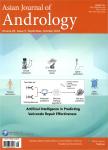Cellular mechanisms regulating sperm-zona pellucida interaction
Cellular mechanisms regulating sperm-zona pellucida interaction作者机构:Reproductive Science Group Discipline of Biological Sciences School of Environmental and Life Sciences University of Newcastle Callaghan NSW 2308 Australia ARC Centre of Excellence in Biotechnology and Development Discipline of Biological Sciences School of Environmental and Life Sciences University of Newcastle CaUaghan NSW 2308 Australia
出 版 物:《Asian Journal of Andrology》 (亚洲男性学杂志(英文版))
年 卷 期:2011年第13卷第1期
页 面:88-96页
核心收录:
学科分类:090601[农学-基础兽医学] 0905[农学-畜牧学] 09[农学] 0906[农学-兽医学] 090501[农学-动物遗传育种与繁殖]
主 题:capacitation fertilization spermatozoa sperm-zona pellucida interaction
摘 要:For mammalian spermatozoa to exhibit the ability to bind the zona pellucida (ZP) they must undergo three distinct phases of maturation, namely, spermatogenesis (testis), epididymal maturation (epididymis) and capacitation (female reproductive tract). An impressive array of spermatozoa surface remodeling events accompany these phases of maturation and appear critical for recognition and adhesion of the outer vestments of the oocyte, a structure known as the ZP. It is becoming increasingly apparent that species-specific zona adhesion is not mediated by a single receptor. Instead, compelling evidence now points toward models implicating a multiplicity of receptor-ligand interactions. This notion is in keeping with emerging research that has shown that there is a dynamic aggregation of proteins believed to be important in sperm-ZP recognition to the regions of sperm that mediate this binding event. Such remodeling may in turn facilitate the assembly of a multimeric zona recognition complex (MZRC). Though formation of MZRCs raises questions regarding the nature of the block to polyspermy, formation and assembly of such a structure would no doubt explain the strenuous maturation process that sperm endure on their sojourn to functional maturity.



